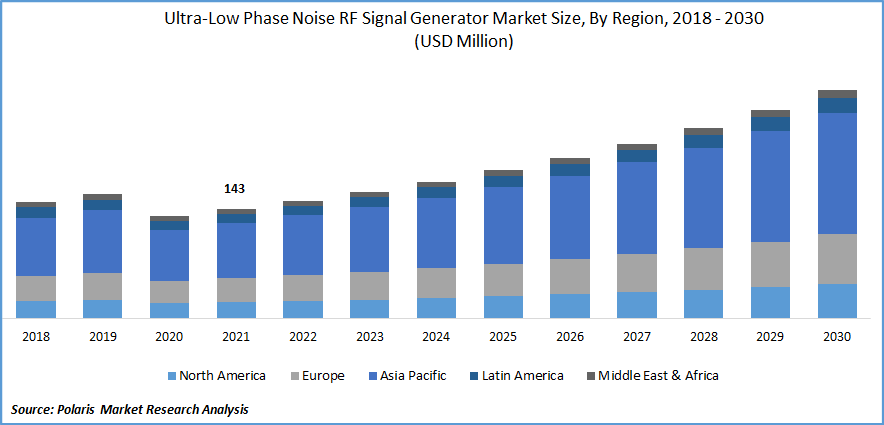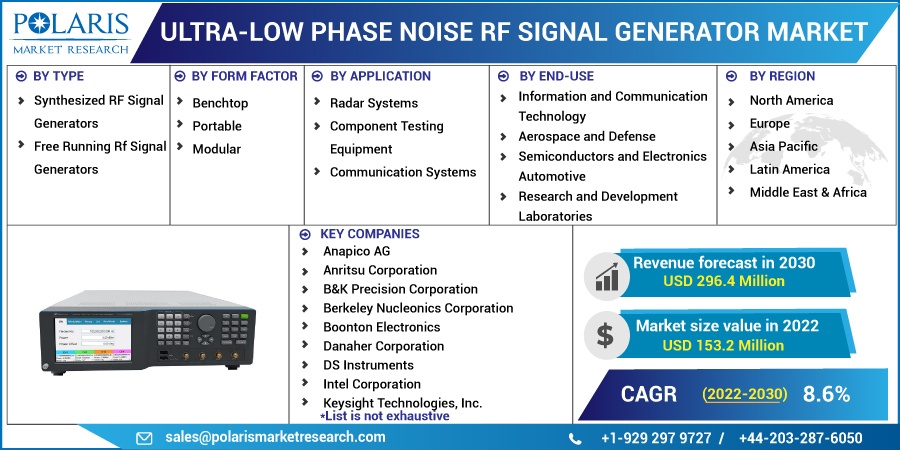
Ultra-Low Phase Noise RF Signal Generator Market Share, Size, Trends, Industry Analysis Report
By Type; By Form Factor (Benchtop, Portable & Modular); By Application; By End-Use; By Region; Segment Forecast, 2022 - 2030
- Published Date:Nov-2022
- Pages: 116
- Format: PDF
- Report ID: PM2826
- Base Year: 2021
- Historical Data: 2018-2020
Report Outlook
The global ultra-low phase noise RF signal generator market was valued at USD 143 million in 2021 and is expected to grow at a CAGR of 8.6% during the forecast period. The growing demand for ultra-low phase noise RF signal generators is expected to be driven by increasing demand for deployment of 5G services, portable and hand RF generators, and the need for testing numerous electronic components.

Know more about this report: Request for sample pages
Rapid urbanization and digitalization have increased the demand for smartphones and smart wearables. The rising need for high-speed bandwidth has increased the sale of low-cost broadband services. Additionally, the continuous high bandwidth requirement increases the demand for 5G network hardware to improve service quality. Furthermore, this 5G connectivity requires testing components such as its cable and antenna systems which is a major factor bolstering the market growth.
The COVID-19 pandemic had a negative impact on the growth of the market. The economic slowdown and negligible operations in the automotive and aerospace industries severely impacted the market. China, the major exporter of raw materials and components of automotive parts, couldn't export the material across countries due to global lockdowns. Furthermore, many manufacturing units were also temporarily halted owing to the government's stringent rule, hampering the market growth.
Innovation and emerging technologies have resulted in the development of wireless communication systems and increased the demand for RF technologies for many end-use applications. But the development and deployment of any new and innovative system requires extensive research and is also a time-consuming process that may result in the decline of the buyers; such factors are restraining the market.
 Know more about this report: Request for sample pages
Know more about this report: Request for sample pages
Industry Dynamics
Growth Drivers
The growing demand for the product across various end-use industries is due to its quick, accurate, and high-volume production. This generator manages product compliance, optimizes test stages, and also looks into the quality of the product after testing, which is expected to spur the market at a higher pace. Moreover, the growing adoption of WI-FI and cellular technologies for information and communication technology applications with the advancement of 5G technologies is expected to raise the demand for ultra-low phase noise RF signal generators.
Furthermore, there is an increased demand for RF technologies in the aerospace and defense industry as it requires high-precision quality signals during flight and in combat. Additionally, RF equipment also delivers a collision avoidance system that alerts pilots about any harsh conditions or other aircraft in the air. Furthermore, aircraft and military vehicles require radar systems, radio monitoring systems, and mission-critical designs for tracking and locating target positions which are anticipated to boost the market growth.
Report Segmentation
The market is primarily segmented based on type, form factor, application, end-use, and region.
|
By Type |
By Form Factor |
By Application |
By End-Use |
By Region |
|
|
|
|
|
Know more about this report: Request for sample pages
Synthesized RF signal accounted for the largest share in 2021
The synthesized RF signal generator market segment accounted for the highest revenue share in 2021, owing to the growing number of high-speed and high-volume production testing. These generators provide high-quality synthesized output with accuracy and minimal phase noise which is expected to drive the market over the forecast period.
Furthermore, these RF signal generators have a wide application in components testing, test systems, and receivers. Additionally, it also generates different types of signals used for Wi-Fi connections, radar, satellite, and cellular communications, which is expected to propel the market growth.
Benchtop form factor is expected to spearhead the market growth
The demand for the benchtop segment is driven by its cost-effectiveness and ability to perform as a single-channel or virtual multi-channel subsystem. The growing demand in research and development laboratories for benchtop signal generators is due to their accuracy, which is increasing its demand across various verticals such as the automotive, telecommunication, and aerospace industry which is expected to fuel the market growth.
Furthermore, the increasing demand for benchtop types across various applications is due to their precise temperature control capacity. Moreover, many providers focus on developing benchtop types according to the client’s specifications. For instance, high-frequency electronics has launched a low-phase noise benchtop with frequency synthesizers that is highly customized, offers RF and microwave designers, and operates at frequencies up to 20 GHz, which are best for most of the tests; these factors are expected to drive the market growth.
Radar system is expected to witness faster growth
The demand for ultra-low phase noise RF signal generators in a radar system is expected to see a significant surge over the forecast period owing to the application of radar test equipment (RTE)in the stages of research, evaluation, and production cycles. The utilization of RTE is usually done in safe and controlled settings where situational complexities are adjusted. In addition, RTE provides better and more accurate results while tasting radar developments and upgrades, which is expected to fuel the market growth.
Furthermore, the radar system handles a range of test metrics and gives excellent results for in-line production, platform integration, and operator training. It has a wide range of applications in fire control, surveillance, imaging, and proximity which is anticipated to boost the market growth.
Automotive segment is expected to account for the largest share in 2030
The automotive segment is expected to dominate the market over the forecast period owing to the rising demand for autonomous and electric vehicles. The increasing complexities of wireless connections have raised the demand for 5G connectivity in connected cars, which is expected to create lucrative opportunities for RF technologies. In addition, this technology had more outstanding results when used for GPS and satellite radio purposes and is still giving excellent results in autonomous vehicles, which is expected to fuel the market over the forecast period.
Furthermore, the evolution of connected cars has resulted in technological advancement in the automotive industry. RF filters are increasing demand in many electric, autonomous, and sports cars as they have a huge amount of wireless signal, and these rf filters avoid undesirable single cross-over. Moreover, self-driving and advanced driver-assistance systems in a vehicle is the emerging trend in the automotive industry which is expected to spur market growth.
Asia Pacific is expected to dominate and witness fastest growth over the forecast period
Asia Pacific is the largest region for ultra-low phase noise RF signal generators. It is expected to witness faster growth over the forecast period owing to the rising demand from R&D laboratories and the requirement for testing and RF measurement techniques and equipment across various end-use industries. In addition, the increasing usage of consumer electronic devices has created a demand for the deployment of 5G infrastructure, and heavy investments by mobile service providers to improve this infrastructure is expected to bolster the market growth.
Furthermore, the presence of electronic and semiconductor manufacturers across developing nations such as China, India, and Japan is also supporting market growth. Moreover, rising government funding to improve the next generation of digital infrastructure and favorable policies related to RF testing solutions are also important factors driving the segment growth.
Competitive Insight
Some of the major players operating in the global market include Anapico AG, Anritsu Corporation, B&K Precision Corporation, Berkeley Nucleonics Corporation, Boonton Electronics, Danaher Corporation, DS Instruments, Intel Corporation, Keysight Technologies, Inc., National Instruments Corporation, Novatech Instruments Inc., Pico Technology, Qualcomm Technologies, Inc., RF Lamba USA LLC, Rohde & Schwarz Gmbh & Co. KG, Saluki Technology Inc., Signalcore Inc., Standford Research System, Tabor Electronics, Tektronix, Inc., Texas Instruments Inc., Transcom Instruments, and Vaunix Technology Corporation.
Recent Developments
In August 2022, Anritsu company partnered with AeroGT labs to offer a best-in-class platform that performs 5G multiple-in multiple-out (MIMO) and over-the-air (OTA) tests on products like vehicles and mobile devices.
In April 2020, Keysight Technologies launched four channeled vector signal generators named M9484C VXG vector signal with specifications like 54 GHz of frequency and 5GHz radio frequency bandwidth along with low phase noise.
Ultra-Low Phase Noise RF Signal Generator Market Report Scope
|
Report Attributes |
Details |
|
Market size value in 2022 |
USD 153.2 million |
|
Revenue forecast in 2030 |
USD 296.4 million |
|
CAGR |
8.6% from 2022 - 2030 |
|
Base year |
2021 |
|
Historical data |
2018 - 2020 |
|
Forecast period |
2022 - 2030 |
|
Quantitative units |
Revenue in USD million and CAGR from 2022 to 2030 |
|
Segments Covered |
By Type, By Form Factor, By Application, By End-Use, By Region |
|
Regional scope |
North America, Europe, Asia Pacific, Latin America; Middle East & Africa |
|
Key Companies |
Anapico AG, Anritsu Corporation, B&K Precision Corporation, Berkeley Nucleonics Corporation, Boonton Electronics, Danaher Corporation, DS Instruments, Intel Corporation, Keysight Technologies, Inc., National Instruments Corporation, Novatech Instruments Inc., Pico Technology, Qualcomm Technologies, Inc., RF Lamba USA LLC, Rohde & Schwarz Gmbh & Co. KG, Saluki Technology Inc., Signalcore Inc., Standford Research System, Tabor Electronics, Tektronix, Inc., Texas Instruments Inc., Transcom Instruments, and Vaunix Technology Corporation. |
